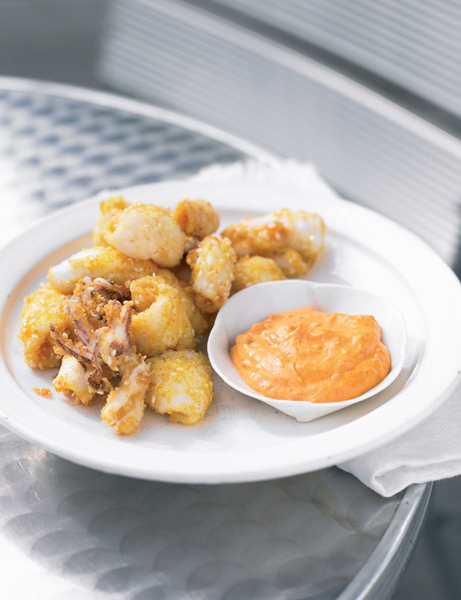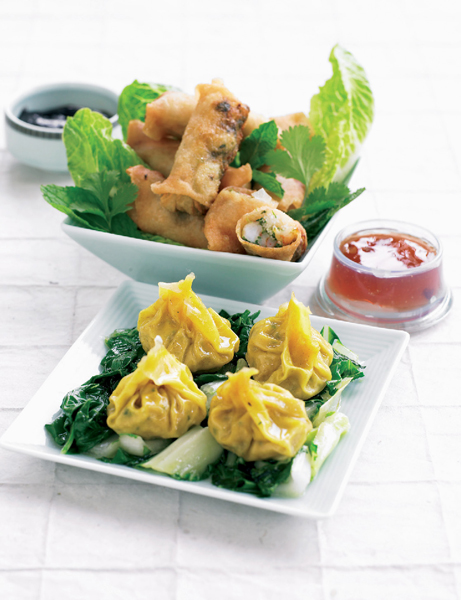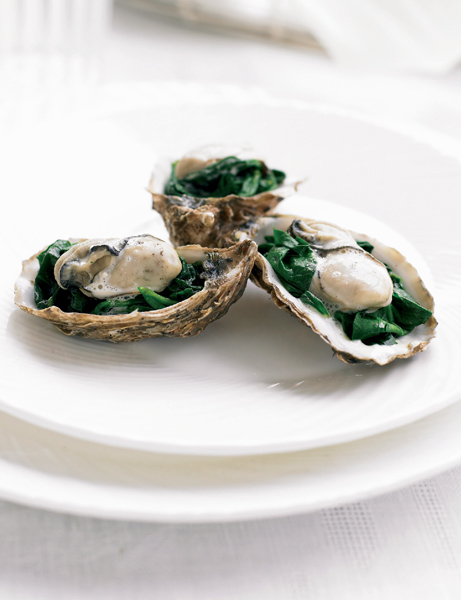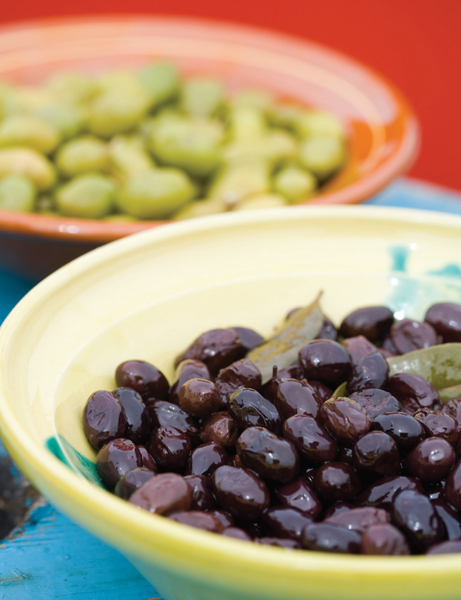
Полная версия
Food from the Sun
Preheat the oven to 200°C (400°F), gas mark 6. Cut the aubergines in half lengthways and trim off the stalks. Brush the cut sides with a little of the oil and sprinkle lightly with salt and pepper. Place cut-side up in a roasting tin along with the whole red peppers and bake for 30–35 minutes or until the flesh of the aubergine is tender and the skin of the red pepper is blackened and blistered.
Remove the vegetables from the oven, put the peppers in a plastic food bag and leave to cool completely. Meanwhile, roughly chop the cooked aubergines, place in a food processor and blend to a purée. Transfer to a bowl and set aside. Once the peppers are cool, remove from the bag, peel away the skin and chop the flesh, discarding the seeds. Place in a food processor and whiz until smooth.
Heat a tablespoon of the remaining olive oil in a large saucepan set over a medium heat. Sauté the onion and garlic for 2–3 minutes until they are softened but not browned. Stir in the cumin seeds and cook for another minute, stirring constantly. Add the roasted aubergine purée and the stock, stirring to combine. Cook over a low heat for 15 minutes until the flavours are well combined and the mixture is heated through. Season with salt and pepper to taste.
Purée the soup with a hand-held blender and ladle into deep soup bowls. Spoon the red pepper purée into the centre and swirl it gently into the soup. To serve, drizzle lightly with the remaining olive oil.
Crispy Fried Squid with Harissa and Crème Fraîche
Serves 4
about 1.2 litres (2 pints) vegetable oil, for deep-frying
450g (1lb) medium-sized squid, cleaned
2 tbsp cornflour
3 tbsp fine semolina
2 tbsp sesame seeds
1 tsp ground paprika
2 tsp harissa paste
120ml (4fl oz) crème fraîche
1 medium-hot red chilli (optional), thinly sliced on the diagonal
2 spring onions (optional), trimmed and thinly sliced on the diagonal
salt and freshly ground black pepper
In Spain there is a type of flour milled especially for frying, called harina de trigo. The closest equivalent in the UK and Ireland is finely ground semolina. For this recipe it’s crucial not to overcook the squid or it will become tough and rubbery.
Pour the oil into a large, heavy-based saucepan or wok and set over a high heat. Alternatively, heat a deep-fat fryer to 190°C (375°F). Cut the body pouch of each squid open along one side and score the inner side with the tip of a small, sharp knife into a fine criss-cross pattern, being careful not to cut all the way through the flesh. Then cut each pouch in half lengthways, then across into 5cm (2in) pieces. Separate the tentacles into pairs.
Put the cornflour, semolina, sesame seeds, paprika and a teaspoon of salt into a plastic food bag. Add the prepared squid, close the bag and shake and toss to coat. Tip out onto a tray, knocking off any excess coating, and leave for 1–2 minutes so that the cornflour mixture becomes slightly damp. This will give a crispier finish.
When the oil is hot enough (it should sizzle fiercely when you drop in a small cube of white bread), fry the squid in batches for 1–2 minutes until it is covered in a crunchy golden coating. Drain on kitchen paper.
Meanwhile, mix together the harissa and crème fraîche in a small bowl and add salt and pepper to taste. Tip the squid onto a serving plate and sprinkle over some chilli and spring onions if you wish. Place the harissa and crème fraîche dip alongside to serve.


Chicken and Wild Mushroom Wontons with Chinese Black Bean Sauce
Serves 6
2 tbsp olive oil
1 garlic clove, peeled and crushed
2 shallots, peeled and diced
175g (6oz) mixed mushrooms (such as shiitake, chestnut and chanterelle), finely chopped
1 tbsp butter, softened
1 tbsp Madeira or ruby port
120ml (4fl oz) double cream
2 tbsp chopped fresh mixed herbs (such as chives, basil and flat-flat parsley)
1 large skinless chicken breast fillet, diced
3 eggs
1 packet wonton wrappers (contains about 30 square wrappers), thawed if frozen
1 pak choi
1 tbsp toasted sesame oil
salt and freshly ground black pepper
For the black bean sauce
2 tbsp Chinese black beans
1 tbsp balsamic vinegar
1 tbsp light muscovado sugar
1 tsp tomato ketchup
1 tbsp dark soy sauce
300ml (10fl oz) beef stock (see page 212)
This is one of the most popular starters in my restaurant. Packets of wonton wrappers can be found in specialist Asian stores, good delis and even some large supermarkets. The wontons are cooked in two stages, first poached and then steamed; if you don’t have a steamer, you could just place them in a pan of boiling water.
To make the sauce, place the black beans in a bowl and cover with hot water, then leave to soak for 5 minutes. Meanwhile, place the balsamic vinegar in a large saucepan with the sugar, tomato ketchup and soy sauce. Cook on a high heat for 1 minute, stirring, then reduce the heat to low, stir in the beef stock and simmer for 10–15 minutes until reduced and thickened. Drain and add the beans, return to a simmer and season with salt and pepper. Remove from the heat, leave to cool completely, then cover with clingfilm and set aside until needed.
To prepare the mushrooms for the filling, heat the olive oil in a large frying pan. Add the garlic, shallots and mushrooms, stir to combine, then add the butter and sautè for 5 minutes. Stir in the Madeira or port, 1 tablespoon of the cream and half the herbs. Season with salt and pepper and leave to cool.
Place the chicken breast in a food processor with two of the eggs, half of the mushroom mixture and the remaining cream. Add two pinches of salt and blend to make a smooth mousse. Place the mousse in a bowl, then stir in the rest of the mushrooms and herbs. Mix well to combine and season to taste.
Bring a large pan of salted water to the boil and keep it boiling while you assemble the wontons. Lay out 18 wonton wrappers on a clean work surface. Beat the remaining egg in a small bowl with a little water to make an egg wash. Brush the edges of each wrapper with the egg wash, then place a teaspoon of the chicken mixture into the centre of each one, being careful not to overfill. Bring all the edges up to meet in the middle and pinch together firmly to seal.
The wontons are now ready to poach. Put them into the boiling water as soon as possible after filling them and poach for about 2 minutes until cooked through and floating at the top.
The next stage is to steam the wontons, although this can be done up to 24 hours later. If you are preparing the wontons in advance, lay them out in a single layer on a tray and leave to cool. Cover with clingfilm and chill. Otherwise, you can steam them immediately.
When ready to steam, arrange the wontons in a single layer in a steamer and cook for about 5 minutes until heated through. If you don’t have a steamer, put the wontons in a large pan of boiling water, cover with a lid and allow to cook for 4–5 minutes.
Separate the leaves of the pak choi and trim down the stalks. Slice each leaf in half lengthways, then plunge into boiling water for 30 seconds; drain well. Heat the sesame oil in a large frying pan or wok and toss the pak choi until just tender and nicely glazed. Season with salt and pepper.
Arrange some of the pak choi on each warmed plate, along with three of the steamed wontons. Add a small dish of the black bean sauce on the side of each plate to serve.
Vietnamese Spring Rolls with Plum Sauce
Serves 4–6
25g (1oz) vermicelli rice noodles
7g (14oz) bunch of fresh coriander, including the roots
1 garlic clove, peeled and crushed
1 tsp freshly ground white pepper
250g (9oz) raw tiger or Dublin Bay prawns (langoustines), peeled, deveined and chopped
1 tsp Thai fish sauce
1 tsp light soy sauce
6 x 25cm (10in) spring-roll wrappers, thawed if frozen
2 egg yolks, beaten
about 1.2 litres (2 pints) groundnut oil, for deep-frying
24 iceberg or Webb lettuce leaves, trimmed, and fresh mint leaves, to serve
For the plum sauce
100g (4oz) caster sugar
2 tbsp rice wine vinegar
6 Chinese preserved plums, rinsed if in brine
pinch of salt
1 tbsp roughly chopped fresh coriander
The perfect starter for any Oriental-themed meal! (See the photograph on page 22.) In Vietnam, the rolls generally contain minced pork, but here I’ve used prawns for a different result. They’re easy to make and the specialist spring-roll wrappers and preserved plums can be bought from Chinese grocers and some larger supermarkets. You can use two ripe fresh plums, with the stones removed, if you prefer.
To make the plum sauce, place 225ml (8fl oz) of water in a heavy-based saucepan with the sugar, vinegar, plums and some salt. Bring to the boil, then lower the heat and simmer until the liquid has reduced by about a quarter. Remove from the heat and stir in the chopped coriander, then use a hand-held blender to mix to a smooth sauce. Transfer to a serving bowl and allow to cool.
Place the noodles in a large bowl and cover with boiling water. Leave for about 5 minutes until softened or according to the packet instructions. Rinse in cold water and, using kitchen scissors, snip the noodles into small lengths. Set aside.
Place the fresh coriander in a mini blender or pestle and mortar with the garlic and white pepper. Blend or pound to a paste, then transfer to a bowl. Stir in the prawns with the fish and soy sauces, then set aside for 5 minutes to allow the flavours to combine.
Cut the wrappers into quarters to make twenty-four 6cm (21/2in) squares. Place a tablespoon of the prawn mixture near one corner of each square, fold in both sides on the diagonal and roll up tightly. Brush a small amount of the beaten egg yolk onto the open end and press the edge closed to seal the spring roll. Repeat with the rest of the wrappers and the remaining prawn mixture.
Place the rolls on a rack until ready to fry. Add the oil to a wok or deep-sided pan and heat until very hot and slightly smoking. Gently drop in as many rolls as will fit in one layer. Carefully fry them for 2–3 minutes until golden brown. Drain on kitchen paper.
Place a hot spring roll on each lettuce leaf and garnish with mint. To eat, wrap the rolls in the lettuce and dip into the plum sauce.
Aubergine and Mozzarella Parcels with Pesto and Sun-dried Tomatoes
Serves 4 | VEGETARIAN
1 large aubergine
120ml (4fl oz) extra-virgin olive oil
2 garlic cloves, peeled and crushed
finely grated rind of 1 lemon
1 ripe beef tomato
2 x 100g (4oz) balls of mozzarella cheese
about 2 tbsp basil pesto
8 sun-dried tomatoes in olive oil, drained and halved
salt and freshly ground black pepper
lightly dressed rocket salad (see page 100), to serve
8 cocktail sticks
These are great for a barbecue, as a starter or an exciting side dish with any kind of meat. They can be made in advance and simply popped on the barbecue just before you want to eat. You could also replace the mozzarella with feta or halloumi.
Trim off the stalk end of the aubergine, then cut lengthways into eight slices, 5mm (1/4in) thick, discarding the ends. Arrange the slices in a single layer on a large baking sheet.
Preheat a griddle pan until very hot, or prepare a barbecue with medium–hot coals. Mix together the olive oil, garlic and lemon rind in a small bowl, season with salt and pepper, then brush the mixture over the aubergine slices. Place the aubergine on the heated griddle pan or the barbecue and cook for 2–3 minutes on each side until charred. Be careful not to cook for any longer or the aubergine will become too soft. Remove from the heat and leave to cool a little.
Slice the top and bottom off the tomato and cut the rest into four thick slices, then cut each slice in half again to make eight pieces in total. Cut each mozzarella ball into four slices. Place the cooked aubergine slices on a clean work surface and place a piece of tomato in the middle of each slice. Arrange a slice of mozzarella on top, then add a small dollop of the basil pesto. Arrange the sun-dried tomatoes on top and season with salt and pepper. Flip over both ends of the aubergine to enclose the filling and secure each parcel with a cocktail stick.
Brush the outside of each parcel with the rest of the garlic and lemon oil and return to the griddle pan or barbecue for 1–2 minutes on each side or until they are heated through and lightly golden. Again, be careful not to overcook. To serve, arrange on warmed plates with the rocket salad.
Cracked Patatas Bravas
Serves 4 | VEGETARIAN
675g (112lb) baby new potatoes, scrubbed
4 garlic cloves, unpeeled
2 tbsp olive oil
1 red onion, peeled, halved and thinly sliced
good pinch of dried chilli flakes
12 tsp sweet or smoked paprika
good pinch of dark muscovado sugar
400g can of chopped tomatoes
1 tbsp sun-dried tomato purée
1 tbsp torn fresh basil leaves
Maldon sea salt and freshly ground black pepper
This is a Spanish tapas favourite and every tapas bar tends to have its own version. It makes a delicious snack in its own right, but is also a fantastic accompaniment to Butterflied Poussin (see the photograph on page 49) or with Blackened Chicken with Roasted Red Pepper and Avocado Salsa (page 41).
Wrap the baby new potatoes in a clean tea towel and hit them gently with a wooden mallet or rolling pin to crack them lightly. Flatten each garlic clove in the same way.
Heat the olive oil in a large frying pan and cook the onion for a minute or two to soften. Tip in the cracked potatoes and garlic and continue to cook for 10–12 minutes until golden, stirring regularly.
Sprinkle the chilli flakes over the potato mixture along with the paprika and sugar. Season with salt and pepper and give everything a good stir to coat the potatoes evenly. Fold in the tomatoes and tomato purée and bring to a gentle simmer.
Cover the frying pan with a lid (a large enough plate would also do the job) and simmer for 15 minutes, stirring every 5 minutes or so to ensure that the mixture cooks evenly, until the potatoes are completely tender and coated in a thick to mato sauce. Stir in the basil and then tip into warmed individual bowls, or serve as a side dish.
Chicken Satay with Pickled Cucumber Salad
Serves 4
4 tbsp dark soy sauce
2 tsp clear honey
2 tsp medium curry powder
450g (1lb) skinless chicken fillets, cut into long strips
salt and freshly ground black pepper
For the pickled cucumber salad
4 tbsp rice wine vinegar
2 tbsp caster sugar
large pinch of salt
12 small cucumber, peeled, halved, seeded and thinly sliced
For the dipping sauce
2 tbsp crunchy peanut butter
2 tsp dark soy sauce
1tsp light muscovado sugar juice of 12 lime
120ml (4fl oz) coconut milk
12 red chilli, seeded and finely diced
2 tbsp chopped fresh coriander
6 wooden skewers (15cm (6in) in length), soaked
This is a classic South-East Asian street food that I enjoyed on a recent trip to the region. Satay has a wonderful balance of sweet and spicy flavours that penetrate the chicken. It is perfect for cooking on the barbecue; just make sure you soak the skewers first.
First prepare the pickled cucumber salad. Place the vinegar in a bowl and stir in the sugar and salt until dissolved. Tip in the sliced cucumber, stir to combine and set aside to allow the flavours to develop.
Preheat a griddle pan until smoking hot, or preheat the grill. Whisk together the soy sauce, honey and curry powder in a bowl. Season with salt and pepper and stir in the chicken pieces. Leave to marinate for a few minutes.
Meanwhile, make the dipping sauce. Heat the peanut butter in a small saucepan over a low heat and stir in the soy sauce, sugar and lime juice. Gradually whisk in the coconut milk until you have achieved a smooth sauce. Stir in the chilli and coriander, then leave to cool.
Thread the chicken pieces onto the pre-soaked wooden skewers and arrange on the griddle pan or under the grill. Cook for 4–6 minutes, turning once or twice, until cooked through.
Arrange the chicken satay skewers on warmed plates. Divide the dipping sauce between individual ramekins and place to one side of the skewers. Drain the pickled cucumber salad, add to the plates and serve at once.

Poached Oysters with Spinach and Lemongrass
Serves 4
16 oysters (Pacific if available)
25g (1oz) butter
225g (8oz) fresh spinach leaves, washed and tough stalks removed
For the lemongrass sauce
1 tsp softened butter
1 shallot, peeled and finely chopped
2 lemongrass stalks, outer leaves removed and core finely chopped
finely grated rind and juice of 1 lemon
150ml (5fl oz) dry white wine
100ml (312fl oz) double cream
salt and freshly ground white pepper
This is the perfect recipe if you want to try cooking or eating oysters for the first time. It might sound fancy, but it’s actually very easy and guaranteed to impress your guests. You can ask your fishmonger to remove all the oysters from their shells or follow the instructions below.
Scrub the oyster shells thoroughly. Place an oyster on a tea towel on a firm surface, flattest shell uppermost and hinge towards you. Gather the tea towel around the oyster and grip it firmly so there is a thick wad of cloth protecting your hand. With the other hand, insert an oyster knife or a sharp rigid blade into the gap in the hinge and twist upwards to snap the shells apart. Slide the blade along the inside of the upper shell to sever the muscle that keeps the shells together. Lift off the top shell and run the knife under the oyster to remove it from the bottom shell. Repeat with the rest of the oysters. Clean the bottom shells and reserve for serving.
To make the lemongrass sauce, melt the butter in a saucepan set over a medium heat. Add the shallot, lemongrass and lemon rind and cook for 2–3 minutes until softened but not browned, stirring occasionally. Pour in the wine and simmer until reduced by half, stirring at intervals. Stir in the cream and bring to the boil, then turn down the heat and simmer for 5 minutes until slightly reduced and thickened. Season with salt and pepper and stir in the lemon juice. Blitz with a hand-held blender and pass through a fine sieve into a clean saucepan. Keep warm over a low heat.
Just before you poach the oysters, melt the butter in a large pan and add the spinach and a pinch of salt. Cook for a minute or so over a high heat until just wilted, then drain off any excess liquid and spoon a mound of spinach into each oyster shell. Arrange on heated plates and keep warm. Add the oysters to the warm lemongrass sauce, still over a low heat, and gently poach for 30 seconds, but no longer. Carefully remove the oysters with a slotted spoon and place on top of the spinach in the shells. Place the hand-held blender in the sauce and blitz to lighten, then spoon the sauce over the poached oysters to serve.


Marinated Olives
Serves 4 | VEGETARIAN
1 tsp cumin seeds
1 tsp fennel seeds
225g (8oz) black or green olives, or a mixture
finely grated rind and juice of
1 small lemon
2 garlic cloves, peeled and crushed
1 tsp dried crushed chillies (optional)
4 tbsp extra-virgin olive oil
In my opinion, the best type of olives for this dish come from Italy and have been stored in olive oil. You’ll find them at farmers’ markets or in a good deli. The longer you leave them to marinate, the better the flavour will be.
Toast the cumin and fennel seeds in a small, dry frying pan for 1–2 minutes until they become aromatic. Tip into a bowl and add the olives, lemon rind and juice, garlic, chillies, if using, and olive oil.
Toss until each olive is well coated and either drain off the excess liquid immediately and tip into small bowls to serve, or leave to marinate and allow the flavours to develop for as long as possible. The olives can be prepared up to one week in advance and stored in a bowl covered with clingfilm in the fridge.
Spiced Glazed Almonds
Serves 4 | VEGETARIAN
1 tbsp olive oil
225g (8oz) roasted salted whole almonds
4 tbsp caster sugar
1 tsp sweet or smoked paprika
1 tsp freshly ground black pepper
These crunchy spiced nuts make an excellent snack to go with a few drinks. I like to use almonds but cashew nuts or pecan halves also work well.
Heat the oil in a frying pan set over a medium heat and add the almonds, stirring to coat. Sprinkle over the sugar, paprika and pepper. Cook for about 5 minutes, stirring constantly, until the almonds are golden brown and the sugar has caramelised.
Spread out on a baking sheet to cool and harden, then break up any clusters as necessary before piling into small bowls to serve.



